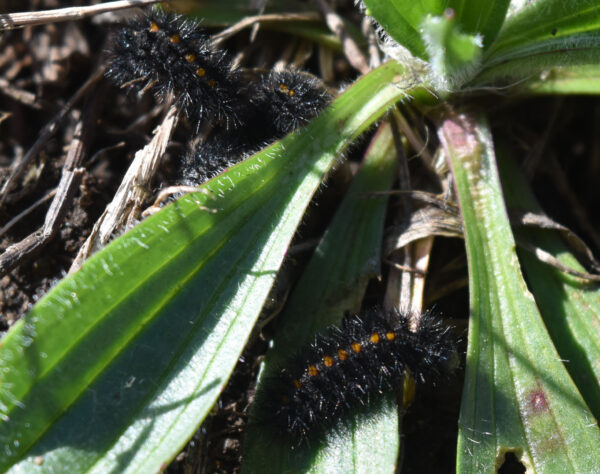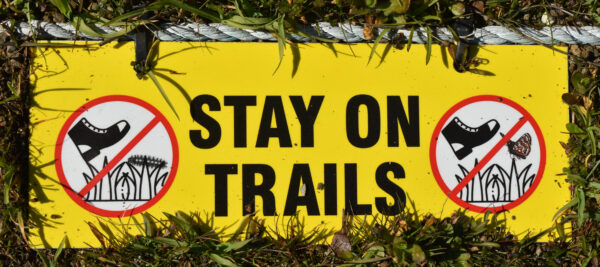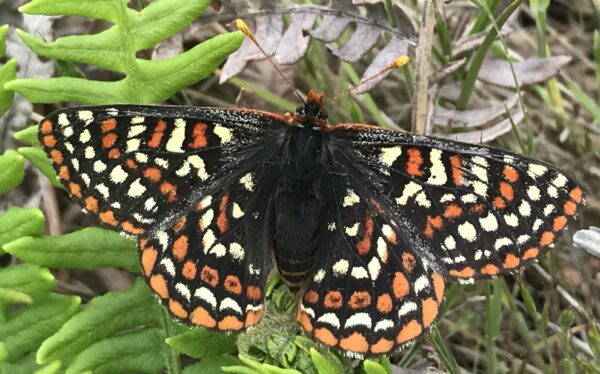More is better for endangered butterflies
By Chris Junck, Taylor’s Checkerspot Butterfly Recovery Project Team
Successful butterfly reintroduction programs have many components. Releasing large numbers of caterpillars into habitat with plenty of adult nectar plants and caterpillar food, are two key components. Mild weather and cooperative park users can be important factors too. Commitment over the long-term and persistence pays off as well. All these things are critical for the survival of endangered Taylor’s checkerspot butterflies in Helliwell Provincial Park.

Taylor’s checkerspot larvae eating plantain leaves shortly after release in Helliwell Park. Photo by Chris Junck.
BC Parks, the Taylor’s Checkerspot Recovery Project Team, First Nations, community volunteers and other partners have been restoring the coastal bluff ecosystem since 2015 to increase the amount of suitable habitat for butterflies and other species. In 2022, approximately 5,000 Taylor’s checkerspot larvae were released into the park’s meadows. This follows release of approximately 800 Taylor’s checkerspot caterpillars in 2020 and 1,300 in 2021. In late March 2023, another 1,300 larvae will be gently placed in the coastal bluff meadows. All the larvae were reared at the Greater Vancouver Zoo, with the support of Wildlife Preservation Canada staff.

Area A in Helliwell Provincial Park is where Taylor’s checkerspot larvae were released previously. Most of the 2023 release sites are in recently restored coastal bluff meadow habitat towards St. John’s Point in Area B. Map prepared by Dawn Marks.
The next few weeks will be a crucial time for butterflies. “Trampling is a key threat for caterpillars and their food plants,” said Jennifer Heron, Chair of the Taylor’s Checkerspot Butterfly Recovery Project Team and invertebrate conservation specialist for the BC Ministry of Water, Land and Resource Stewardship.

Please stay on marked trails and watch out for caterpillars. Photo by Chris Junck.
Helliwell’s visitors can increase the caterpillars’ chance of survival by complying with park rules. Dogs must be on a leash according to provincial park regulations and bikes aren’t allowed in this park. Please tread carefully and watch out for caterpillars. Stay on the trails that are delineated by ropes and restoration area signs. Do not move or pick up Taylor’s checkerspots. Instead, report sightings to Taylors.Checkerspot@gov.bc.ca, or by using the free iNaturalist app (www.inaturalist.org). It’s an easy-to-use species identification tool that enables citizen scientists to record and contribute important species data for projects around the globe.
The recovery initiative required extensive habitat restoration in the park, such as selective tree and invasive plant removal, and adding native plants and seeds. Although focused on Taylor’s checkerspot butterflies, several other at-risk and uncommon coastal bluff species benefit from this project, such as dun skipper butterflies and about a dozen other range-restricted butterflies, western bumble bee, bats, western screech-owl, and numerous other birds and plants.
BC Parks and the project team thank the Cowichan Tribes, Halalt, Homalco, K’ómoks, Lake Cowichan, Lyackson, Penelakut, Qualicum, Snaw’Naw’As, Stz’uminus, Tla’amin, We Wai Kai, and We Wai Kum First Nations for allowing us to restore ecosystems in their traditional territories. There has also been a lot of local assistance for the project from Helliwell Park neighbours in High Salal Ranch Strata, volunteers, Conservancy Hornby Island, the Hornby Island Natural History Centre, and Hornby Island Provincial Parks Committee.
The recovery project has benefited from funding and in-kind contributions from the BC Parks Licence Plate Program, the Habitat Conservation Trust Foundation, the Environment Canada Habitat Stewardship Fund and the B.C. Ministry of Water, Land and Resource Stewardship, and others.
The Taylor’s Checkerspot Butterfly Recovery Project Team includes biological consultants and representatives from the B.C. Ministry of Water, Land and Resource Stewardship, BC Parks, Denman Conservancy Association, Garry Oak Ecosystems Recovery Team, Greater Vancouver Zoo, Mosaic Forest Management, Wildlife Preservation Canada, and others.

Taylor’s checkerspot butterfly. Photo by Jennifer Heron.
Learn more about the Taylor’s checkerspot butterfly:
and